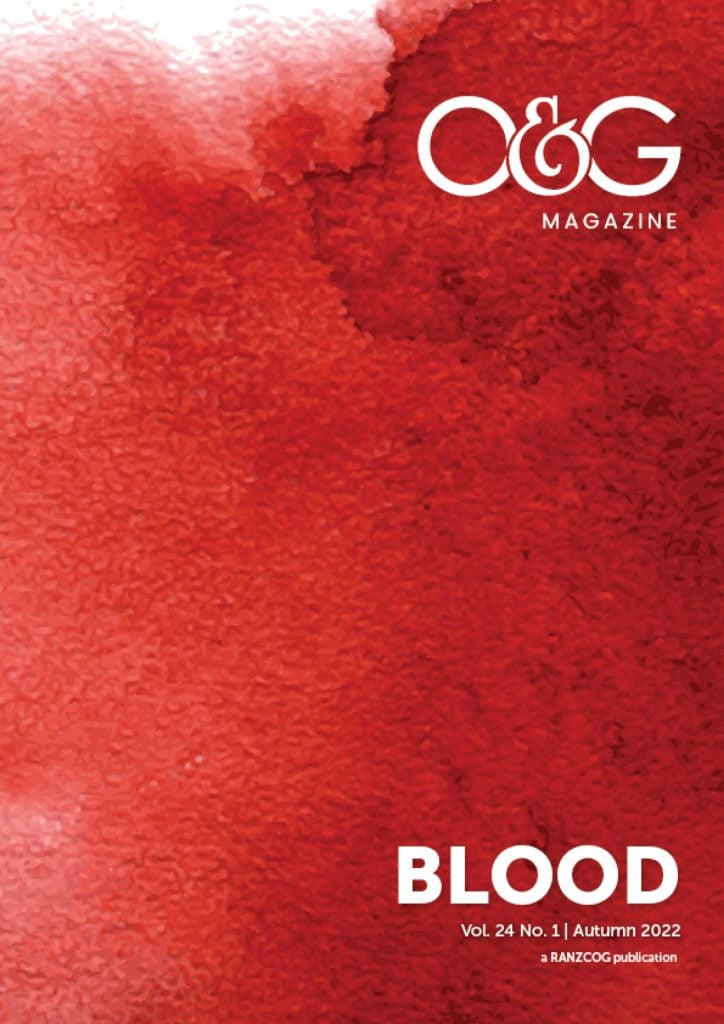Welcome to the first article from the RANZCOG Consumer Network Working Group (CNWG) for 2022. The CNWG has had many discussions around topics across obstetrics and gynaecology since the group was created in late 2020.
Recently I had the joy of talking with Dr Kara Thompson (obstetrician at Western Health and Barwon Health) about the importance of consumer engagement and how her practice as an obstetrician has changed after listening to many consumer stories with Dr Alex Umbers (GP obstetric trainee) on their podcast, ‘Pregnancy Uncut’. Dr Thompson explained that ‘I thought I had a solid understanding of obstetrics and all its joyful, tragic and unpredictable permutations. I had read all the textbooks and sat all the exams and worked in the field for a decade. But as doctors we only have a true understanding of what the experience is like from a professional perspective, and perhaps one or two personal experiences of our own. Over the last year I have sat down over a cup of tea with birthing families who have experienced various complications in their pregnancies and listened. I mean really listened. Not ticking all the boxes of a postpartum review or a standardised debrief.’
With the focus on postpartum haemorrhage (PPH) for this issue, I had a discussion with 63 consumers who had endured a PPH. PPH is one of the most common birth complications and leader worldwide for morbidity and mortality, but what does it mean for the consumer, the birthing partner and families? How does it really feel for them and how can obstetricians, midwives and other health professionals use this consumer experience to better their practice and improve health outcomes? Amy Dawes, co-founder of Australasian Birth Trauma Association (ABTA) works with many birthing consumers and their families and believes that PPH is a ‘huge trigger for birth trauma for the many families that we support (both the birthing and non-birthing parents).’
After having four babies myself and having multiple PPHs, one over three litres and then the last being over eight litres requiring an emergency transfer and subsequent hysterectomy to preserve life, I have learnt that my experience and the feelings that arose were similar to other women who experienced mild to catastrophic PPHs. They often report common short- and long-term effects.
The birth of your children, either vaginally or via caesarean section, is a significant moment in your life: something that comes with great anticipation and sometimes a little trepidation. We all hope and wish that things go perfectly well, even though we understand the risks that come with childbirth.
During the discussion, 92% of consumers reported that their PPH occurred during or after the third stage of labour, as did my own. The shock and relief of having their baby was shortly followed with what many described as a fear for their life. It was commonly noted that patients felt like there was something majorly wrong with them before anyone else in the room realised, yet they felt unable to advocate those feeling due to the shock setting in. At this point, they talked about the moment they wanted to ‘fight’ for life against the strong urge to drift to sleep because the pain and weakness was too much, a feeling that all never forgot.
A PPH comes with a sense of emergency, the button being pushed, the rush of staff into the room, the look of concerned faces and sometimes the shock of seeing the amount of blood in the room. It is in these moments that the consumers notice the little things, the body is hypervigilant. The sounds, the smells, what people are wearing, the numbers from the blood pressure or heart rate and the words being spoken often stay with them for years to come. If the consumer develops symptoms of post-traumatic stress disorder (PTSD) in the future, these are often the source of triggers for them. Dr Thompson also learnt that ‘everything you say to a woman in their pregnancy may be that comment they remember forever. Almost every woman has several quotes they can directly recall from their births, including who said it and most importantly, how it made them feel. What may be a throwaway comment on a busy night running between birthing rooms may be the words that run through their minds, often during those lonely 3am feeds, for months and years to come’.
The women expressed that once settled in their rooms and the emergency had subsided, they were overcome with great fatigue and weakness, feelings of dizziness and were scared to move. Many felt robbed of their time with their little ones due to these affects. The shock of what had just happened and the feeling of failure as a birthing person crept in. In some cases, the separation from their little ones hurt even more, yet that gratitude for still being alive was strong, even though they were angry at the situation that had unfolded. The women in this discussion ranged from six weeks to five years postpartum and all had different stories to share long term. For myself, it wasn’t until later that I realised the true effects of what my body had endured. I was so focused on surviving, getting better and back to my baby that the psychological aspect of the experience didn’t hit until eight weeks postpartum. The psychological aspect of the birth often surprised many other consumers and as they felt like they ‘didn’t come out from under the cloud’ for months. That extreme fatigue and shortness of breath continued when doing small tasks and it consumed them.
Over half the consumers reported that they had PTSD-like symptoms, anxiety, and problems within their families from a lack of understanding, which led to a feeling of loneliness. Birthing partners often experienced their own form of trauma in relation to the birth, and this at times made it difficult for them to connect as a family. The women felt like they needed extra care during this time but also felt reluctant to speak to a health professional about this due to stigma. The inclusion of their partners and birthing partners during discussion was appreciated and gave them a feeling of acknowledgement. The women needed to be seen, heard, and reassured by their health team that they had indeed suffered something difficult. Amy Dawes added that ‘to help ward off potential traumatic stress, communication was key, through the process, never underestimate the kind words, gentle touch, letting them know that you are there (and if you can’t, making sure there is someone that is explaining what is happening).’
Debriefing was the most valued form of aftercare that made a distinct difference to their health outcomes; however, there were definite characteristics that defined successful debriefing. Consumers suggested that the most effective debriefing was provided immediately, again in the following days and then over the coming weeks and months. 35% of the consumers noted that they couldn’t process the debriefing until two years later when they were diagnosed with PTSD or had worked with a psychologist. They found that often their body was still in ‘protection’ mode and their ability to understand and accept what had happened was low. Another defining characteristic was who the debrief came from. 96% of the consumers insisted that they needed to debrief with the obstetrician and midwife involved with their birth rather than a GP or hospital management. They felt they had developed the relationship with these people and needed to discuss it with who was there. This was more important for people who experienced life-threatening PPH. Dr Thompson agreed with ‘the importance of timely and ongoing debrief after every birth, not just for those who we might consider having had a traumatic experience. Almost every woman we have spoken to has some degree of confusion about why something was done during their labour or pregnancy. Part of addressing this, in addition to routine birth debriefing, is improving women’s access to comprehensive antenatal education to empower them with knowledge about the birth process and possible complications, before they arise’.
Amy Dawes felt that ‘providing adequate aftercare and opportunity to ask questions’ was essential. She agreed that this could be ‘weeks or months after as it often takes people some time to process the experience and recognise that they need to talk and understand’. Her Peer2Peer support structure has been heavily welcomed by birthing families as they have been able to connect with others who have experienced similar complications.
With the added difficulty of COVID-19, where consumers have had less support in the birthing room and during the hospital stay, many felt that it was more important than ever to have trauma informed care and that the health professionals in the room had an added responsibility for awareness to help the birthing person feel safe and supported to reduce PTSD, postnatal depression and postnatal anxiety. In the immediate moments of the PPH, the women valued the health professionals who spoke to them in a way they understood, and someone who took them seriously when they explained concerns such as feeling dizzy, weak, heavy in the chest or in pain. One woman expressed that due to a language barrier and no support during COVID-19 restrictions, she was unable to communicate her concern to the attending doctors and nurses. She felt that the importance of a translator being available in an emergency when her birthing partner was unable to attend would have been highly valued.
100% of the women recalled that their experience really scared them and their family, that they were afraid of having future children even though they desired a larger family. They felt the need for reassurance from their obstetrician and a higher level of informed care. The consumers that proceeded to have another child felt safer when their healthcare team explained how they could prevent another PPH and how they would be treated in the event of another PPH. This also included explaining the risks and providing options. Continued reassurance and understanding also contributed to feeling at ease. Many women also noted that EMDR (eye movement desensitization and reprocessing) helped with extreme cases.
In conclusion, the CNWG looks forward to working with RANZCOG over the coming years to strengthen the collaboration between consumers and clinicians, to plan, evaluate and improve their clinical practices for better public health outcomes.
Our feature articles represent the views of our authors and do not necessarily represent the views of the Royal Australian and New Zealand College of Obstetricians and Gynaecologists (RANZCOG), who publish O&G Magazine. While we make every effort to ensure that the information we share is accurate, we welcome any comments, suggestions or correction of errors in our comments section below, or by emailing the editor at [email protected].






Leave a Reply